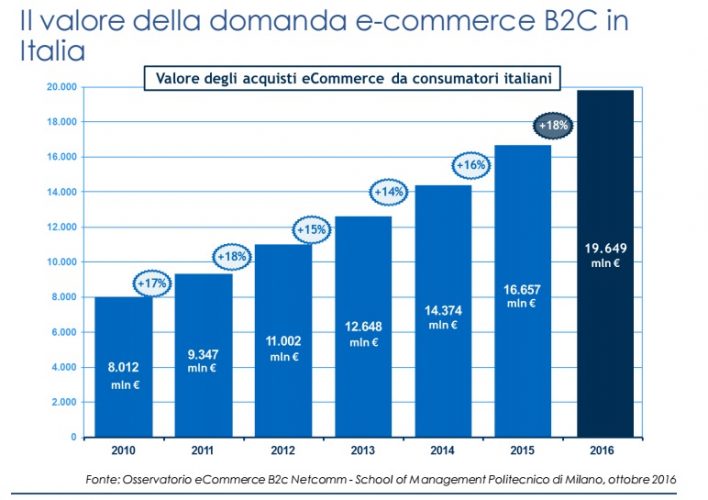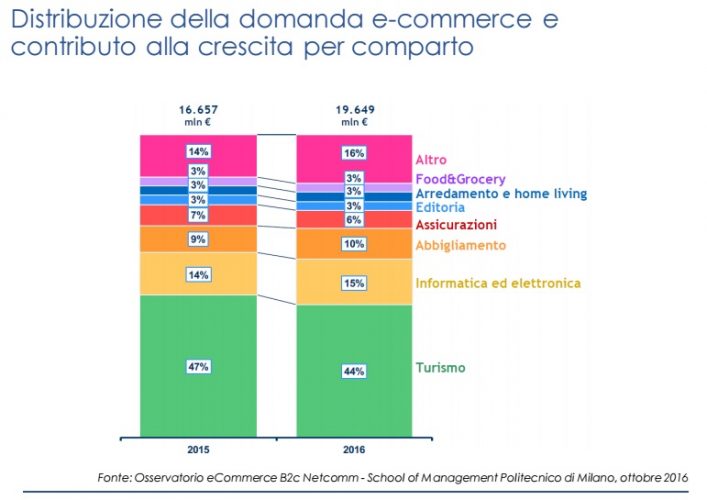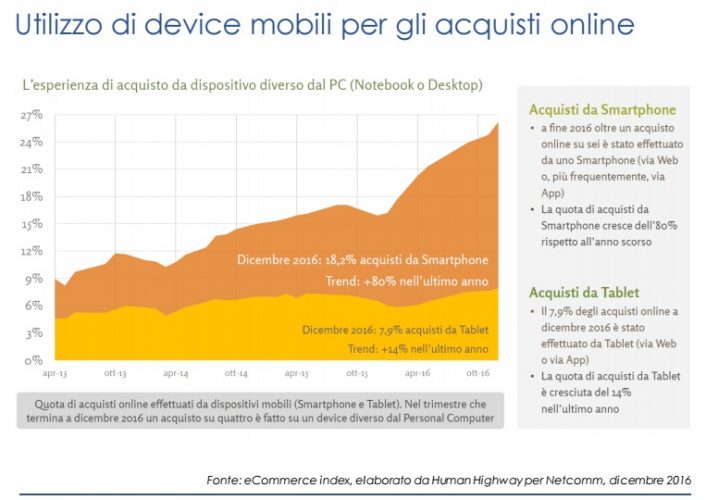Ecommerce in Italy
Ecommerce continues its rise. A +10% increase was recorded in 2016, with the number of usersreaching 20.7 million.
The value of transactions increased by +18% to nearly 20 billion euros.
For 2017, annual growth of +19 percent is expected, with a transaction volume of about 23.5 billion euros.

You can still grow
While the numbers seem to speak for themselves, it is clear that much more can be done when you consider that the average annual online shopping expenditure in Italy is lower than in Europe and that of the 30 million Italians who surf the Internet, 10 do not buy online.
It’s boom for fashion and food ecommerce
83.6 percent of Italian Internet users have bought online at least once in their lifetime, 51.6 percent do so habitually.
Sectors with growing trends for 2017 include: furniture and home living (48 percent), food & grocery (30 percent), and publishing (+16 percent).

The fashion industry
The increase in the fashion industry with a growth rate of 10 percent is surprising.
Fashion was the first industry that led toomnichannelality, with the phenomenon of offline sales influenced by online.
The food sector
The food sector is expected to grow the most in the coming years.
Italy is still lagging behind countries such as France or England, but the speed with which services such as Just Eat and Deliveroo, the challenge launched by Coop alliance to Amazon on fresh home delivery, have been appreciated, hints at how interesting business models will be developed in the short term.
Mobile and online shopping
While computers still remain the tool of choice for online shoppers, smartphones and tablets are gaining ground: as of December 2016, 26.1 percent of purchases were made from tablets or smartphones.
And while purchases from PCs in 2016 grew by +14% (compared to 2015), transactions from mobile devices grew by+80%.

The importance of logistics
In the coming years, another aspect will have a strong development: that of delivery.
The ability to offer efficient and fast delivery and pickup services seems to be emerging as one of the main competitive territories on which e-commerce challenges will be played out in the coming years.
Just think of Amazon, which offers one-day delivery (Prime), one-hour delivery(Prime now) or pickup of products at post offices.
Just think of drone deliveries, active in the U.K., being tested in Italy by the Air Force for medicine deliveries in deprived areas.
The future is also made up of deliveries.
And from home delivery, pickup points are taking more and more space.
Do you also want to because in Italy it still does not cease a natural inclination to the cash or otherwise delivery payment method, particularly by those buyers less comfortable with electronic payment systems.
Eprice (Banzai) was the first merchant in Italy to build a network of di pick.up point (now 117) that also allow payment on pickup and was the first merchant to launch along with Inpost a network of vending machines ( Lockers) for roadside pickup of purchased products (while developing home pickup of used appliances, as required by law).
The critical issues of food delivery
In the field of online shopping or e-grocery, there are many critical logistical issues.
Just think of fresh, frozen, long-distance or quick home delivery.
Then there are also the issues of goods not being available while placing the order online (finished on the shelf), returns, and missed deliveries.
It is clear how, for each criticality, practitioners need to make distinct service choices and strategies.
Let’s cite a few examples: the specialty food retailer sector, such as Eataly, are often characterized by products with good value versus weight (wine or specialty food) and thus the ability to deliver to very large, cross-country or cross-continental catchment areas.
Small producers, on the other hand, use their own vehicles, which are able to meet deliveries of fresh or frozen, in a local area, quickly and efficiently.
Otherwise, estimated volume and packaging costs, and a multiple purchase option for B2B, can enable lower shipping costs and greater purchase outcomes.
In the case of ready-to-eat , there are models such as Foodora and Deliveroo that have made the logistics platform their raison d’être. Key logistical elements include: smart packaging designed for individual dish and transport modes, advanced algorithms to estimate delivery times and define accessible restaurants at individual delivery addresses, but, most importantly, a order tracking system among the most advanced, allowing the customer to monitor on the map where and how their delivery is moving, even to the point of being able to whatsapp the biker who is making the delivery.
Questions to ask yourself to be competitive
What does our site look like, how does it navigate, is it mobile friendly?
Are logistics and prices adequate and competitive with competitors?
If you can’t answer these questions
we can do a proper analysis of your ecommerce or suggest how you can succeed in selling more.
Contact us.
READ ALSO.
Share on: